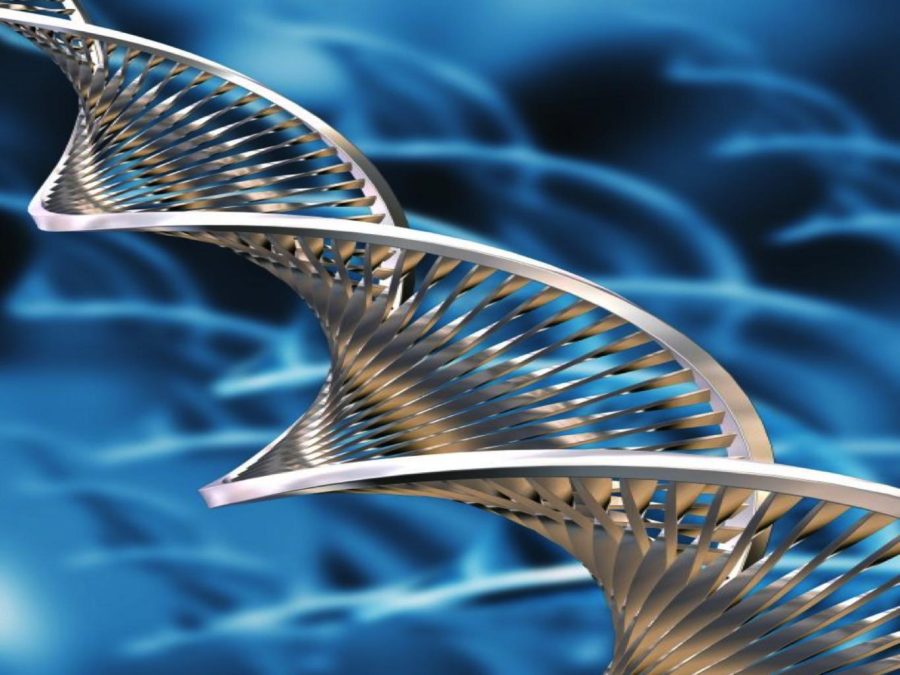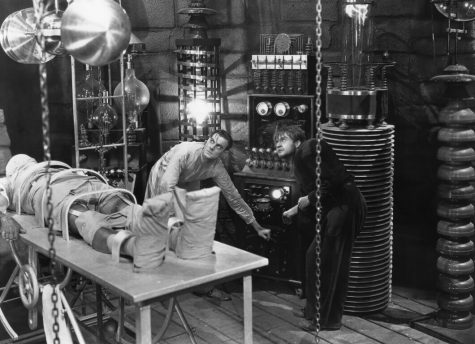Frankenstein & Biological Engineering
Humans have now developed the technology to manipulate many of the laws of nature, with the potential to fundamentally alter the uniformities and regularities of the natural world. Recent advances in technology have allowed for major discoveries in the fields of human genetics and biological engineering. The fields of genetic and biological engineering defy Darwin’s theories of evolution and encompass the applications of purposeful embryo selection of desirable traits, and gene therapy and genome sequencing, both of which modify human genes. Since the 1970s, revolutionary inventions of new “technologies for isolating, locating, manipulating and analyzing genes” (Kevles, 1) in human DNA have been created. Genes control the chemical reactions within a cell and determine the growth and function of an organism (Mullis), so new genetic modification technology allows the enhancement of human traits, such as intelligence, appearance, personality, and physical abilities (So). Dating back to the late eighteen hundreds, the idea of genetically favoring traits has been controversial. Proposed by Sir Francis Galton, Darwin’s cousin, in 1885, the idea of selecting culturally favorable genes in society through natural selection and sterilization emerged. Unfortunately, this field of research was accompanied by the idea of eugenics which held that “the physical, mental, and behavioral qualities of the human race could be improved by suitable management and manipulation of its hereditary essence” (Kevles). These ideas set off the dark and disturbing path of eugenics, sterilization, infanticide, and arguably Nazism, which all aimed to eliminate the “defectives” or “undesirables” within society. Recent arguments against genetic engineering have depicted the field as an attempt at eugenics through the use of technology (MU School of Medicine). Before that time, however, the young imaginative author of Frankenstein, Mary Shelly, foresaw both the exhilarating and fascinating possibilities of genetic modification and the potential downfalls and consequences of physically changing a being by bypassing the laws of nature. These ideas are illustrated and represented through the story of the Wretch, the being like no other created by Frankenstein–physically powerful and invincible, yet emotionally lonely, suicidal, and vengeful. Although more exaggerated than modern genetic and biological engineering applications, Frankenstein may well foreshadow today’s concerns about the consequences of biological modification.
Biological engineering allows for revolutionary medical, healthcare, evolutionary, and economic applications. New therapeutic branches of biological and genetic engineering consist of gene therapy and purposeful embryo selection. These hold the potential to control, prevent, and cure genetic diseases, limit physical disabilities, and very well alter the future of the human race. Medical possibilities include the diagnosis, treatment, and prevention of complex conditions such as diabetes, cancer, heart disease, and asthma (Frontier Technology Quarterly). Notably, “gene therapy and the use of genetically-modified viruses to fight disease is becoming increasingly common” (McBride). Genetically engineered viruses can be used in gene therapy “for the treatment of genetic diseases, cancer-killing viruses, vaccine development, and boosting immune cells” (Shabir). Scientists are focused on preventing and eliminating illnesses in unborn or even preconceived fetuses. This prevention is summarized by Michigan State University of Medicine, “If done on reproductive cells, gene therapy could keep children from carrying such genes (for unfavorable genetic diseases and disorders) that the children got from their parents.” These two components put forth the possibility of “improving quality of life and life expectancy” (Frontier Technology Quarterly), and could decrease future medical costs tremendously (McBride), benefitting society and the economy. Biological engineering defies Darwin’s theories of natural selection and could improve the human race’s ability to adapt to dramatically changing environmental factors (Metzl). This technology could extend the survival of the human race and prevent “extinction level events” (Metzl). As this new branch of research continues to develop, it is definite that many more revolutionary medical breakthroughs will be made. Biological and genetic engineering is just getting started.
Similar to modern biological advances, by harnessing and manipulating the laws of nature, Frankenstein created the Wretch, a super being with incredible physical abilities. Frankenstein replicated the basic outline of “the fine form of a man” (Shelly, 44) but added certain modifications that gave the creature un-human abilities. The Wretch was increased in size and had a “gigantic stature” (72), which would undoubtedly “exceed that of a man” (97). He possessed “superhuman speed” (97), and had a “height superior to” (99) and “joints more supple” (99) than those of humans, which gave him incredible and advantageous power, speed, and agility. Even more so, he was fit to survive the harshest conditions and “bore the extremes of heat and cold with less injure” (126). The Wretch could “subsist upon coarser diet” (126) than that of humans, even with his towering structure. These traits of survival enhanced his strength and endurance. All of these physical abilities and advantages were due to Frankenstein’s ability to harness and manipulate nature’s laws. Although modern biological modification is different from Frankentein’s methods and scientific practices, the possibilities are unnervingly similar. The possibility of creating physically advanced and “superhuman” people is in the near future, and not too far from Mary Shelly’s Wretch.
Although biological and genetic engineering possesses many positive attributes and possibilities, there are underlying consequences and shortfalls. As the technology of biological modification is still new and developing, there are many unknowns and possible dangers. Scientists and researchers are now contemplating possible conflicts and issues that may arise with the development of biological engineering. As genetic modification changes our genes, this technology may irreversibly change future generations (Gyngell). Large-scale genetic modification could result in a decrease in genetic diversity which could spur numerous dangerous outcomes. Diversity is essential as “Human groups benefit from certain types of diversity, including immuno-diversity (diversity in the genes that influence innate immunity) and cognitive diversity (diversity in the genes that affect our cognitive traits)” (Gyngell). By repeatedly favoring certain genes and discarding others, genetic variation within the human race will gradually decrease. By conducting numerous studies on genetic diversity within plant and animal populations, a well-supported understanding has been formed that lacking genetic diversity “severely restricts a population’s ability to adapt to changing circumstances” (Weeks) and will “increase the risk of extinction” (Hoffman). Even more so, if the technology and capability of biological engineering is exploited, inequalities within society will likely be exacerbated down to a structural molecular level. With the ability to create “designer babies and super-humans” (Frontier Technology Quarterly), culturally valuable trait gaps (intelligence, appearance, physical abilities, personality, and health) within society will be created. Societal inequality could result in a divided society with complex social and political implications. Racial prejudice and ideologies of social group dominance will likely arise. As seen throughout history, starting with Sir Frances’s proposal, “genetic explanations have been used to designate some groups as genetically (or constitutionally) inferior and to justify oppression and discrimination” (Shostak). Additionally, access to the advanced technology of genetic modification will likely be limited (Frontier Technology Quarterly) due to expense and accessibility ($1,100 per genome in 2017), raising issues of social and financial disparity within society. Gene therapies are being marketed to wealthy individuals as “The cost of gene therapies for rare diseases as approved in the United States and Europe can range from $373,000 to $1 million per patient per year” (Frontier Technology Quarterly). On a global level, genetic engineering may “exacerbate existing inequality in health outcomes between rich and poor nations” (Frontier Technology Quarterly). Political and constitutional issues may also arise globally, as germline editing (which affects all of an organism’s cells including the reproductive cells) is currently prohibited in many countries as well as by international human rights treaties (CGS). Because germline editing affects future offspring, questions of ethical boundaries, privacy, and informed consent are arising. With the ability to genetically modify unborn children, how will we attain the consent of an unborn individual to change both their and their offsprings’ genetic makeup? The technology of genetic engineering is evolving and spreading rapidly, as are such concerns and consequences. The future could become an unstable free-for-all arms race to genetically improve society based on cultural values if not correctly monitored and supervised. Genetic engineering has the potential and means to do tremendous good, but society must take precautions and be aware of the dangers.
Modern dangers and negative consequences of biological engineering are mirrored by Mary Shelly’s Frankenstein through the tale of the Wretch. Although a more exaggerated outcome of today’s scientific possibilities, they share many parallels. Frankenstein equipped the Wretch with super-human physical abilities such as strength, stature, and endurance, yet caused him unavoidable psychological harm by physically changing the creature. For both the better and the worse, the Wretch was a creature like no other. Frankenstein’s physical changes to the Wretch had not only physical implications, but emotional and social as well. Due to his physical uniqueness and variation, the Wretch faced indifferent and biased treatment from others “prejudice against me” (142), which consequently left him with a negative view of himself and denied him true and necessary relationships, “I was wretched, helpless, and alone” (137). Because of his appearance, he was instantly rejected and outcast by his creator and society, “No mortal could support the horror of that countenance.” (53). They thought of him as a creature “more hideous than belongs to humanity” (72), and so they deprived him of human interaction. More so, biologically changed, the Wretch was an inhuman and alienated creature with a confused identity and insufficient relationships. The Wretch’s physical differentiation isolated him, “I had never seen a being resembling me or who claimed any intercourse with me” (126). Being a creature of a completely separate species, the Wretch was left with questions about his identity “What did this mean? Who was I? What was I? Whence did I come? What was my destination?” (136), and was left lonely and confused. The Wretch felt like an alienated creature, even a monster, “when I looked around I saw and heard of none like me. Was I then a monster…” (126). More so, the Wretch’ s physical differentiation caused him to question his self-worth, and he considered himself “miserable beyond all living things” (99). As his feeling of isolation developed, so did his self-hatred, and he became hateful and ashamed of his appearance “my form is a filthy type of yours, more horrid…I am solitary and abhorred” (139). So much harm was done that the Wretch became suicidal “Cursed, cursed, creator! Why did I live? Why, in that instant, did I not extinguish the spark of existence which you had so wantonly bestowed?” (144). Although the Wretch was physically improved and advanced compared to man, he suffered many emotional and psychological consequences. Whether it be in Mary Shelly’s Frankenstein or modern biogenetic engineering, the act of alienating a creature by physically separating it from its species may spur underlying consequences such as isolation, self-hate, and potential self-harm.
Biological and genetic engineering is a prominent topic that will continue to be controversial as new technology and ideas develop. There is no clear answer as to whether this new technology will provide more benefit than harm. The fields of genetic and biological engineering are still new and expanding and hold many unseen consequences and possibilities, perhaps including those of alienation and psychological harm foreshadowed in Mary Shelley’s Frankenstein. It is evident that therapeutic gene therapy has the means to do tremendous good by preventing and treating complex and fatal diseases and conditions; however, concerns regarding ethics, human diversity, and eugenics are arising. Just as Frankenstein manipulated the laws of nature to create a super-being, humans can now manipulate specific genes to favor culturally valuable traits within society and disregard others less desirable. Social and political conflicts are on the rise, which may trigger class disparities and exacerbate racial ideological prejudice and discrimination. It is impossible to predict exactly what the future holds, but as long as society continues to have informed conversations grappling with the risks and benefits of genetic and biological engineering, there’s hope to avoid a modern-day version of Mary Shelly’s disturbing vision.
Duster, Troy. “Backdoor to Eugenics”. Backdoor to Eugenics, Routledge; New York:
2003a. doi.org/10.4324/9780203426951. Accessed 12 February, 2023.
FRONTIER TECHNOLOGY QUARTERLY. “Playing With Genes: The Good, the Bad and the Ugly.”
FRONTIER TECHNOLOGY QUARTERLY, May 2019,
www.un.org/development/desa/dpad/wp-content/uploads/sites/45/publication/FTQ_May_2019.
pdf. Accessed 7 Mar. 2023.
Furlan, Elise et al. “Small population size and extremely low levels of genetic
diversity in island populations of the platypus, Ornithorhynchus anatinus.”
Ecology and evolution vol. 2,4 (2012): 844-57. doi:10.1002/ece3.195. Accessed 12 February, 2023.
Gyngell, Christopher. “Gene Editing and the Health of Future Generations.” Journal of the Royal
Society of Medicine, vol. 110, no. 7, SAGE Publishing, 26 Apr. 2017, pp. 276–79.
doi.org/10.1177/0141076817705616. Accessed 8 Mar. 2023.
Kevles Daniel. “In the Name of Eugenics: Genetics and the Uses of Human Heredity.” Alfred
A. Knopf; New York: 1985.
books.google.com/books?id=ni-BQ0hKpBwC&printsec=frontcover&source=gbs_ge_su
mmary_r&cad=0#v=onepage&q&f=false. Accessed 12 February, 2023.
K.N.C. “How genetic engineering will reshape humanity” The Economist. 25 April, 2019.
tinyurl.com/kn2fmzuz. Accessed 12 February, 2023.
Metzl, Jamie. Hacking Darwin. Sourcebooks, 7 April 2020. Accessed 13 Feb. 2023.
McBride, Aloha. “10 Ways Digital Could Transform Healthcare.” EY – Global, 24 Aug. 2020,
www.ey.com/en_gl/digital/10-ways-digital-could-transform-healthcare. Accessed 7 Mar. 2023.
MU School of Medicine. “Gene Therapy and Genetic Engineering – MU School of Medicine.”
MU School of Medicine,
medicine.missouri.edu/centers-institutes-labs/health-ethics/faq/gene-therapy. Accessed 12 Feb. 2023.
Mullis, Elise, et al. “Genes Made Easy.” East London Genes & Health,
www.genesandhealth.org/genes-your-health/genes-made-easy. Accessed 9 Mar. 2023.
Shabir, Osman. “How Could a Virus Be Genetically Engineered?” News-Medical.net, 10 Mar. 2021,
www.news-medical.net/health/How-Could-a-Virus-be-Genetically-Engineered.aspx. Accessed
7 Mar. 2023.
Shelly, Mary. Frankenstein. Gallery 13 ed., New York City, Simon & Schuster,
Inc., 2021.
Shostak, Sara, et al. “The Politics of the Gene: Social Status and Beliefs about Genetics for
Individual Outcomes.” Social psychology quarterlyvol. 72,1 (2009): 77-93.
doi:10.1177/019027250907200107. Accessed 12 February, 2023.
So, Derek. “From Goodness to Good Looks: Changing Images of Human Germline Genetic
Modification.” Bioethics, vol. 36, no. 5, Wiley-Blackwell, June 2022, pp. 556–68.
doi.org/10.1111/bioe.12913. Accessed 9 Mar. 2023.
Unknown.“5 Reasons to Say No to Genetically Modified Humans.” Center for Genetics and
Society(CGS),
www.geneticsandsociety.org/internal-content/5-reasons-say-no-genetically-modified-hum
ans. Accessed 12 Feb. 2023.
Weeks, Andrew, et al. “MOVE IT OR LOSE IT: EXPLOITING GENETIC DIVERSITY TO
FIGHT EXTINCTION.” University of Melbourne, 14 Apr. 2016, pursuit.unimelb.edu.au/
articles/move-it-or-lose-it-exploiting-genetic-diversity-to-fight-extinction. Accessed 12
Feb. 2023.
Zoppi, Lois. “Genetic Manipulation Can Double Life Expectancy and Increase Health of Offspring.”
News-Medical.net, edited by Kate Anderton, 20 June 2019,
www.news-medical.net/news/20190306/Genetic-manipulation-can-double-life-expectancy-and-
increase-health-of-offspring.aspx. Accessed 8 Mar. 2023.








